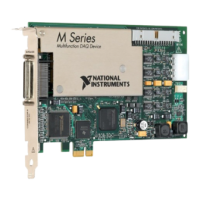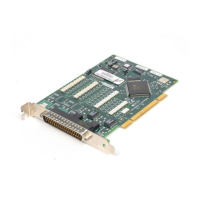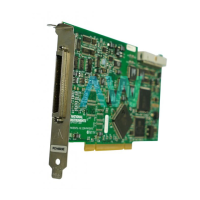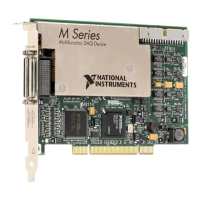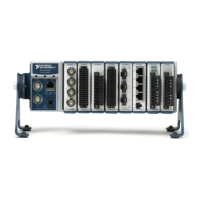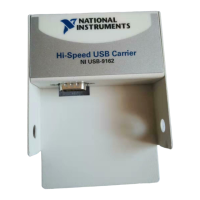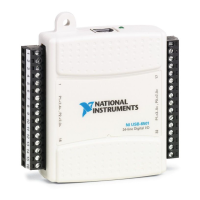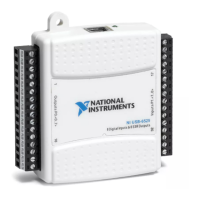© National Instruments | 4-45
X Series User Manual
Minimize noise pickup and maximize measurement accuracy by taking the following
precautions:
• Use individually shielded, twisted-pair wires to connect AI signals to the device. With this
type of wire, the signals attached to the AI+ and AI- inputs are twisted together and then
covered with a shield. You then connect this shield only at one point to the signal source
ground. This kind of connection is required for signals traveling through areas with large
magnetic fields or high electromagnetic interference.
• Route signals to the device carefully. Keep cabling away from noise sources. The most
common noise source in a PCI DAQ system is the video monitor. Separate the monitor from
the analog signals as far as possible.
• Separate the signal lines of the Simultaneous MIO X Series device from high-current or
high-voltage lines. These lines can induce currents in or voltages on the signal lines of the
Simultaneous MIO X Series device if they run in close parallel paths. To reduce the
magnetic coupling between lines, separate them by a reasonable distance if they run in
parallel, or run the lines at right angles to each other.
•Do not run signal lines through conduits that also contain power lines.
• Protect signal lines from magnetic fields caused by electric motors, welding equipment,
breakers, or transformers by running them through special metal conduits.
Refer to the Field Wiring and Noise Considerations for Analog Signals document for more
information. To access this document, go to ni.com/info and enter the Info Code rdfwn3.
Minimizing Drift in Differential Mode
If the readings from the DAQ device are random and drift rapidly, you should check the
ground-reference connections. The signal can be referenced to a level that is considered floating
with reference to the device ground reference. Even though you are in DIFF mode, you must still
reference the signal to the same ground level as the device reference. There are various methods
of achieving this reference while maintaining a high common-mode rejection ratio (CMRR).
These methods are outlined in the
Connecting Analog Input Signals section.
AI GND is an AI common signal that routes directly to the ground connection point on the
devices. You can use this signal if you need a general analog ground connection point to the
device.
Analog Input Timing Signals
In order to provide all of the timing functionality described throughout this section,
Simultaneous MIO X Series devices have a flexible timing engine. Refer to the
Clock Routing
section of Chapter 9,
Digital Routing and Clock Generation.
Simultaneous MIO X Series devices use AI Sample Clock (ai/SampleClock) to perform
simultaneous sampling on all active analog channels. Since there is one ADC per channel,
AI Sample Clock controls the sample period on all the channels in the task.
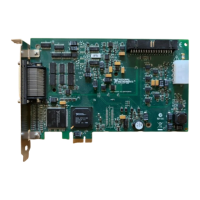
